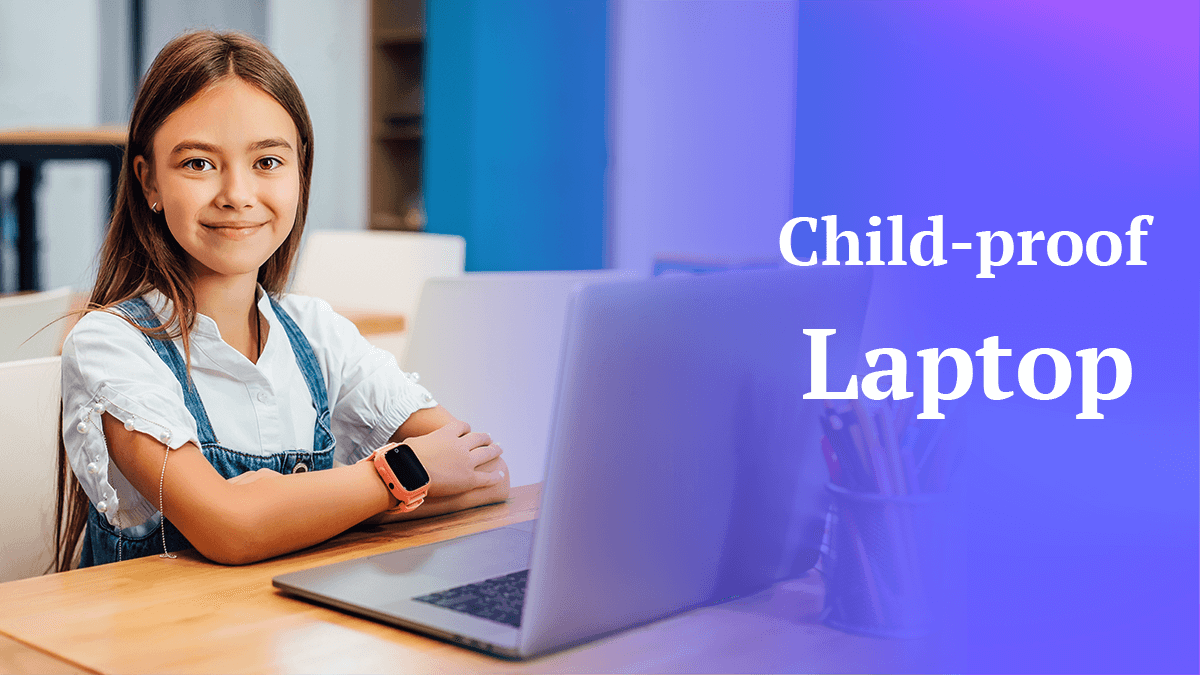
How to Set Up Child Protection on a Computer in 2025: Mac & Windows Parental Controls
- Table of Contents
- 1. Set Up Parental Controls
- 2. Set Up Accounts for Kids and Adults
- 3. Log Out of Online Accounts & Turn off Autofill
- 4. Consider a Kid-Friendly Browser
- 5. Use Your Router to Block Websites
- 6. Install Antivirus Software
- 7. Inspect the Laptop Regularly
- 8. Talk to Your Kids
- Conclusion: Make Your Laptop Child-Proof
The best ways to keep your children from misusing electronic devices are to set up separate restricted accounts for kids, use parental control settings and restrict their online accounts using allowlists.
Kids are curious little creatures. However, this curiosity can land them in dangerous situations if not supervised. So if you have young children running around under your roof, it’s time for you to learn how to set up child protection on a computer, tablet or other tech device.
First, if your child has been doing distance learning lately, you may have noticed that the device formerly known as “your” computer has been conscripted for their studies. It’s time to make peace with this fact!
However, it’s a good idea to take steps to childproof your device to minimize the chance of them venturing into dangerous websites, meeting cyber predators or accidentally spending $10,000 on Minecraft skins.
Keep reading to find out how to child-proof laptop computers and tablet devices today, so your younger children’s internet experience stays kid-safe. I’ll go over Windows
How do I childproof my child’s computer?
The top methods include setting up separate restricted user accounts for your children, using parental controls and encrypting sensitive data on the computer.What is the safest laptop for kids?
A laptop is only as safe as you make it for your child. No matter what laptop you get them, install virus protection and enable security settings for your kid’s online safety.What age is appropriate for a laptop?
The best age to introduce laptops to your kids depends on the child’s learning stage and their ability to grasp the importance of staying safe on the internet.
1. Set Up Parental Controls
Many parents want to protect kid’s privacy online, keep them safe and still give them enough freedom to explore. A great way to do that is to enable parental controls through your computer’s system preferences. Windows and Mac laptops have built-in parental controls you can access at any time.
The parental-control strategy comes in two parts. The first is to set up the laptop so that your kid can’t mess around with any of the settings or install any software (like a VPN). The second is to teach your kid how to use the machine safely.
Let’s explore how to set this up on the Mac and Windows operating systems.
How to Set Up Parental Controls on Windows 11
- Click on Start and then Settings
- Click Accounts
- On the left side panel, choose Family & other users
- Click the option to Add a family member
- Select Add a Child and input your child’s Microsoft email address. If your child doesn’t have an email address, click The person I want to add doesn’t have an email address
- The Child account will be added to your list of family members. It will be activated with the default parental control settings
- To refine settings, click on Manage family settings online in the same panel and adjust the parental control settings
How to Set Up Parental Controls on Mac
- Click on the Apple icon and then click System Preferences
- Click on the Parental Controls button
- Select the child’s account that you wish to put controls over
- Click on the lock symbol at the bottom left of the panel to make changes
- Enter your administrator password to unlock Parental Controls preferences
- Set restrictions as you wish for Apps, Web, Stores, Time, Privacy and Other
2. Set Up Accounts for Kids and Adults
A great way to reduce the chances of your child stumbling across something unsavory on your computer is to create your own user account, as well as password-protected accounts for your kids to use instead of the main login. Set different permissions for their accounts that limit what they can access.
If you have more than one child, give them each separate user accounts with their individual passwords and privileges. Only designate adult accounts as “administrators” with the ability to access all files. Then, when your 4-year-old child thinks it would be fun to delete all your files, they can mess with their own stuff but nothing else.
3. Log Out of Online Accounts & Turn off Autofill
Staying logged into your account is like wedging your super-secret key permanently into all of your doors. Avoid the autofill feature for sensitive accounts. If your kid gets on the computer while you’ve left your admin account logged in, you don’t want them accessing your email or bank account.
Using strong passwords is one way to keep both hackers and kids out of your account. To create a strong password, you should aim to use a combination of at least eight letters, symbols and numbers that can’t be easily guessed. You can also use password managers like LastPass that automatically create and safely manage strong passwords for your accounts.
4. Consider a Kid-Friendly Browser
You can get your kid to use kid-friendly browsers like Kiddle or Pikluk, which are designed for kids and are filled with only appropriate content. These browsers curate the content themselves through a database of pre-approved content.
All your kid’s searches will exclude any links from the “bad parts” of the internet, thereby actively seeking to block out harmful content. However, keep in mind that even though a lot of websites are blocked, others could still manage to slip through the cracks. It’s not 100% guaranteed to always work.
5. Use Your Router to Block Websites
If you want to block websites on your home network, the easiest way to do it is with your router. Most routers have a very similar interface and a similar process for setting up parental controls.
DNS filtering works by preventing your devices from contacting certain websites at all. This is different from simply blocking the site in your browser; it prevents anyone connected to your WiFi network from contacting the site with any device. This makes it much harder for kids to get around the blocks.
How to Block a Website With Your Router
To do this, you can open your router settings and adjust parental controls. Most mainstream internet service providers have tutorials on their sites for you to learn how to do this, but the process is pretty similar for all of them.
All you have to do is open your web browser and type in the IP address for the router you use. A page will pop up where you can enter the username (usually admin) and password for your router. Click to login, and you’ll be able to view your router’s settings.
6. Install Antivirus Software
There are two main types of anti-malware programs.
First, there are the types like Microsoft Windows Defender and Kaspersky’s free virus scanner tool that search your computer for existing infections and remove them.
The second type guards your computer by preventing new threats from downloading. The latter includes popular antivirus software like Norton, McAfee and Avast antivirus protection.
I recommend having both kinds on your computer so you can have additional resources handy when you need them.
7. Inspect the Laptop Regularly
Most parents have found ways to keep their kids safe on the web. But whatever method you choose, don’t assume your child-proofing measures are working perfectly.
Every now and then, look over your child’s account and see if everything is good. You can access their account using your admin privileges and restrict access if you find out they’ve been accessing dangerous sites. Even if you tell your kids they can come to you with any question or problem, there may still be situations when they don’t ask for help.
8. Talk to Your Kids
As with any parenting issue, it is important to discuss expectations and concerns with your child. Let them know what you would like to see them do or not do online. It is possible to protect your child from harm without taking away all of their freedoms.
Set Basic Rules
Have some basic rules about computer use that everyone in the family can agree on. For example, no talking to people who seem suspicious or inappropriate, no buying things online without parental supervision and no gaming for excessive hours.
You can set screen time limits to cap your child’s access. Encourage them to limit laptop use and get out into the real world. A child’s time should never be totally consumed by their family computer.
Negotiate Rewards & Punishments
Let your children know that they are expected to follow these rules when using the computer. You may want to reward good behavior by giving them more freedom when they demonstrate responsibility with the computer. You can punish bad behavior by taking away certain privileges, like online or phone time, if they break the rules or don’t follow through on responsibilities set by their parents.
You can punish bad behavior by taking away certain privileges, like online or phone time, if they break the rules or don’t follow through on responsibilities set by their parents.
Explain Why
Most of all, make sure you’re communicating why you’re doing this. Just like in the old fairy tales, if you don’t tell a child why they shouldn’t do something, they might be even more tempted to do it.
It’s hard for most kids to see the dangers behind the internet, but you have to go the extra mile to keep your child safe as a parent. You can even check with your child’s school to see if they have an internet awareness program.
Conclusion: Make Your Laptop Child-Proof
Parents are becoming more aware that their children are increasingly adept at utilizing technology. This can be both good and bad, depending on how it is used.
You can ensure it stays on the sunny side of things by child-proofing their devices. Once you do, you’re all set to let your little ones get creative while keeping your child safe.
Happy (and safe) exploring!

Leave a Reply